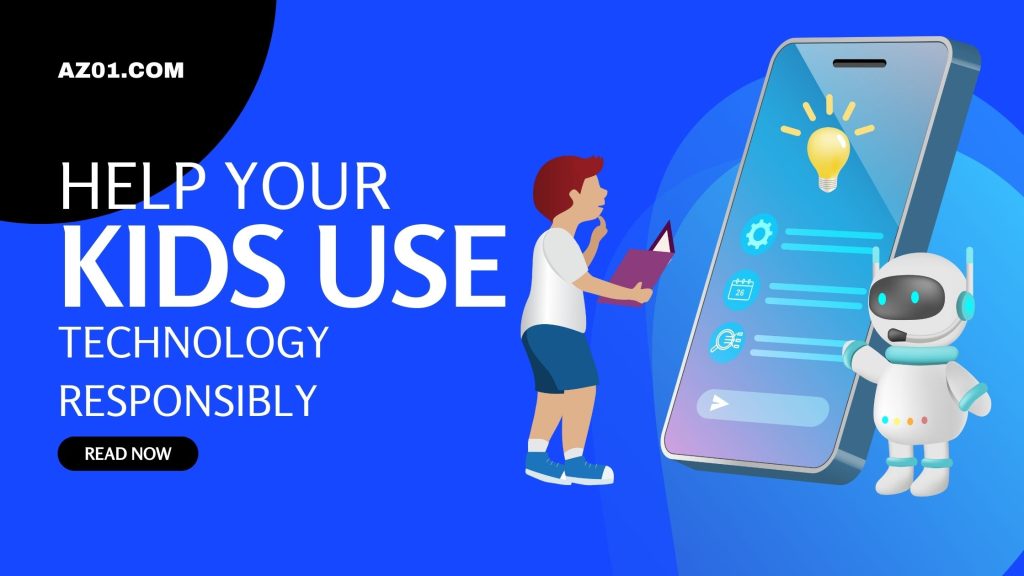In today’s digital age, technology has become an integral part of our lives, including our children’s. While technology offers numerous benefits, it’s essential to ensure that kids use it responsibly. In this blog post, we will explore practical strategies and tips to help parents and educators promote responsible technology use among children. By prioritizing their safety, teaching healthy habits, and setting boundaries, we can empower kids to navigate the digital world responsibly.
How can we use technology safely for kids?

- When it comes to ensuring the safety of children while using technology, a proactive approach is crucial. Here are some effective measures:
a. Set up parental controls: Most devices and applications have built-in parental control features that allow you to restrict access to inappropriate content and set time limits. - Educate on online safety: Teach your kids about online dangers such as cyberbullying, online scams, and the importance of safeguarding personal information. Encourage open communication about their online experiences.
- Monitor their activities: Keep an eye on your child’s online activities without invading their privacy. Maintain an open dialogue about responsible internet use.
- Use age-appropriate content: Choose age-appropriate apps, games, and websites that align with your child’s developmental stage. Look for educational content that promotes learning and creativity.
How can I use technology responsibly?

As parents or guardians, our own responsible technology use sets an example for our children. Here are some tips for modeling responsible behavior:
a. Limit screen time: Establish reasonable screen time limits for both yourself and your children. Dedicate time for non-digital activities, such as reading, outdoor play, and family interactions.
Be present and engaged: Prioritize quality time with your children by actively participating in their technology-related activities. Discuss their favorite games, apps, or websites, and show genuine interest in their online experiences.
Practice digital etiquette: Teach your children about online manners, such as being respectful in virtual communication, not sharing personal information with strangers, and avoiding cyberbullying.
Balance technology use: Encourage a balance between productive and recreational technology use. Introduce educational apps, creative platforms, or coding activities that stimulate learning and critical thinking.
How can you promote responsible technology use among your students?
For educators, fostering responsible technology use is equally important. Here are some strategies to promote responsible technology use among students:

Digital citizenship education: Incorporate digital citizenship lessons into the curriculum, teaching students about their rights and responsibilities as digital citizens. Focus on topics like online privacy, cyberbullying prevention, and responsible social media use. Create technology contracts: Establish technology contracts or agreements with students, outlining acceptable behavior, rules, and consequences related to technology use. This helps set clear expectations and promotes accountability.
Collaborate with parents: Maintain open lines of communication with parents to ensure consistency in promoting responsible technology use both at school and at home. Share resources, tips, and strategies to create a cohesive approach.
Foster critical thinking skills: Encourage students to think critically about the content they encounter online. Teach them how to evaluate information, identify reliable sources, and question the credibility of online content.
How do you break a child’s technology addiction?
If you suspect your child has developed an unhealthy addiction to technology, here are some steps to help them break free:
- Set limits and boundaries: Gradually reduce screen time and establish clear boundaries for technology use. Encourage alternative activities such as hobbies, sports, or social interactions.
- Encourage offline engagement: Plan engaging activities and outings that don’t involve screens. Encourage your child to explore other interests and hobbies that capture their attention.
So What we learn

In this digital age, teaching our children responsible technology use is paramount. By implementing strategies that prioritize their safety, model responsible behavior, and promote critical thinking, we can help our kids navigate the digital world with confidence and responsibility.
Safety measures like setting up parental controls, educating children about online dangers, and monitoring their activities create a secure online environment. Equally important is modeling responsible technology use ourselves by setting screen time limits, engaging in offline activities, and practicing digital etiquette.
For educators, integrating digital citizenship education into the curriculum, establishing technology contracts, collaborating with parents, and fostering critical thinking skills are effective ways to promote responsible technology use among students.
Should you encounter technology addiction in your child, setting limits, encouraging offline engagement, and leading by example are vital steps to break the cycle and regain a healthy balance.
By empowering our children to be responsible digital citizens, we equip them with the necessary skills to make informed decisions, protect their privacy, and contribute positively to the digital world. With vigilance, open communication, and a focus on balance, we can help our children thrive in today’s technology-driven society while ensuring their well-being and development beyond the screens.






